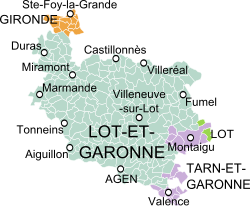Agenais
County of Agenois | |||||||
|---|---|---|---|---|---|---|---|
| 886–1791 | |||||||
 | |||||||
| Capital | |||||||
| Religion | Catholicism | ||||||
| Government | County | ||||||
| Legislature | Parlement | ||||||
| Parliament of Bordeaux | |||||||
| Historical era | Middle Ages/Early Modern | ||||||
• Established | 886 | ||||||
• Disestablishment of the Provinces | 1791 | ||||||
| |||||||
Agenais(French pronunciation:[aʒ(ə)nɛ]), orAgenois(French pronunciation:[aʒ(ə)nwa]), was an ancient region that became acounty(Old French:contéorcunté) of France, south ofPérigord.[1]
History
[edit]In ancientGaulthe region was the country of theNitiobrogeswithAginnumfor their capital, which in the fourth century was the Civitas Agennensium, which was a part ofAquitania Secunda[2]and which formed thediocese of Agen.From 833 to 848, all the land seems to have been ravaged by the Vikings.[3]Having in general shared the fortunes ofAquitaineduring theMerovingianandCarolingianperiods, Agenais from about 886 became an hereditary county in the part of the country now calledGascony(Vasconia).[4][5]The first count of Agenais (comte d'Agen) was William I of Périgord (d. 920), son ofWulgrin I of Angoulême.
In 1038 this county was purchased byWilliam, Duke of Aquitaine and Count of Poitiers.The marriage ofEleanor of Aquitainewith the futureHenry II of Englandin 1152 brought the county under the sway of thePlantagenethouse of Anjou. WhenRichard Coeur-de-Lionmarried his sister Joan toRaymund VI, Count of Toulouse,in 1196, Agenais formed part of the princess's dowry, and formed part of the other estates of the last independentcount of Toulouse.[4]In 1212, during theAlbigensian Crusade,Simon de Montfortcaptured theCatharfortress ofPenne-d'Agenaisand burned Cathars at the stake.[6]At the1259 Treaty of Paris,Louis IX of Franceagreed to pay an annual rent toHenry III of Englandfor Louis' possession of Agenais.[7]The estates of Agenais lapsed to the crown of France in 1271.[4]
This, however, was not for long; the king of France had to recognize the prior rights of the king of England to the possession of the county, and restored it to him in 1279. During theHundred Years' Warbetween the English and the French, Agenais was frequently taken and retaken, the final retreat of the English in 1453 at last leaving the king of France in peaceable possession.[4]
In 1561,Guyennewas made aprovince,and includedBordelais,Bazadais,Limousin,Périgord,Quercy,Rouergue,Agenais,Saintonge,andAngoumois.[citation needed]Thenceforth Agenais was no more than an administrative term. At the end of theAncien Régimeit formed part of theGouvernementofGuienne,and at theRevolutionit was incorporated within the département ofLot-et-Garonne,of which it constitutes nearly the whole. The title of count of Agenais, which the kings of England had allowed to fall into desuetude, was revived by the kings of France, and in 1789 was held by the family of thedukes of Richelieu.[4]
Notes
[edit]References
[edit]- Richard Stillwell, ed.Princeton Encyclopedia of Classical Sites,1976:"Aginnum (Agen), Lot-et-Garonne, France"
44°12′N0°37′E/ 44.20°N 0.62°E
- ^Mish, Frederick C., Editor in Chief. "Agenais".Webster's Ninth New Collegiate Dictionary.9th ed. Springfield, MA:Merriam-WebsterInc., 1985.ISBN0-87779-508-8,ISBN0-87779-509-6(indexed), andISBN0-87779-510-X(deluxe).
- ^Alexander Riese,Geographi Latini Minores,1878, "Notitia Galliarum"p. 143
- ^Tholin, G."L'Agenais (in French)".Imago Mundi.Serge Jodra.Retrieved11 December2014.
- ^abcdeOne or more of the preceding sentences incorporates text from a publication now in thepublic domain:Bémont, Charles(1911). "Agenais".InChisholm, Hugh(ed.).Encyclopædia Britannica.Vol. 1 (11th ed.). Cambridge University Press. p. 373.
- ^Joseph Noulens,Le comté d'Agenais au xe siècle(Paris, 1877).
- ^William W. Kibler, ed.Medieval France: an encyclopedia,s.v."Agenais".
- ^Harry Rothwell, ed.English Historical Documents 1189–1327,Routledge, 1996,ISBN0-415-14368-3
- Agenais
- Geography of Gironde
- Geography of Lot (department)
- Geography of Lot-et-Garonne
- Geography of Tarn-et-Garonne
- History of Nouvelle-Aquitaine
- History of Occitania (administrative region)
- History of Gironde
- History of Lot (department)
- History of Lot-et-Garonne
- History of Tarn-et-Garonne
- Guyenne
- Former counties of France
- Former provinces of France
